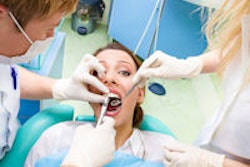
In a review of studies measuring the effectiveness of midlevel dental providers (MLPs), dental teams that included MLPs showed a decrease in untreated caries among some patients but no difference in caries increment or severity, the researchers reported in the Journal of the American Dental Association (February 2015, Vol. 146:2, pp. 134-135). However, the reviewers noted that the quality of the evidence was poor.
Dental caries is the most common chronic disease in children and adults, and it disproportionately affects people of lower socioeconomic status, the study authors noted.
Public policymakers across time and cultures have implemented workforce models that include MLPs who perform irreversible (invasive) procedures, surgical procedures, or both, in part to equalize disparities and improve access to care, according to the review.
Alaska, Minnesota, and Maine are the only states that have authorized MLPs in the U.S. Dental hygiene therapists have been practicing for decades in 53 other countries.
The ADA-funded review included 18 observational studies spanning five countries and 60 years that were published through February 2012. Nine reviewers sought to evaluate the effectiveness of workforce models that include MLPs. What are the changes in caries increment or the amount of untreated caries among patients when MLPs conduct diagnostic, treatment planning, or surgical dental procedures? And what about the impact of MLPs on the cost-effectiveness of dental care?
Review criteria required a comparison group: either MLP versus dentist or patients receiving no care, or care delivery at two time points by MLPs. MLPs in the review performed irreversible procedures, such as cavity preparation or extractions.
Of the 7,701 citations screened, 18 observational studies met the inclusion criteria. The reviewers judged only one study to have a low risk of bias; the remaining 17 were deemed to have moderate to high risks of bias.
Results
“Teams incorporating midlevel providers showed a decrease in untreated caries across time, but no difference in caries increment or severity.”
Some patient groups that received irreversible care from teams that included MLPs showed decreases in caries increment, caries severity, or both across time, the survey found. However, they researchers found no difference in caries increment, caries severity, or both when compared with patients in which dentists provided all the irreversible treatment.
In contrast, patients who received irreversible dental treatment from teams that included MLPs showed a decrease in untreated caries across time and a decrease in untreated caries compared with patients in which dentists provided all treatment, the study authors wrote.
The reviewers found no data regarding cost-effectiveness, irreversible diagnostic procedures, or diseases other than caries.
Conclusion
The quality of the evidence was poor, concluded the reviewers, noting that many studies were excluded because they were too old or differed greatly in the clinical approaches or methods they used.
"Reducing disparities is imperative; however, disparities result from multiple factors," wrote Rebecca Schaffer, DDS, an adjunct faculty member at the Arizona School of Dentistry and Oral Health, in a commentary included in the review. "Informed policymaking requires careful consideration of the quality and scope of the evidence that is used to support workforce model changes."
Dental therapists and hygienists worldwide offer safe, effective dental care, especially for children, according to studies by the Pew Charitable Trusts, the W.K. Kellogg Foundation, and the National Governors Association. In 2013, the U.S. Federal Trade Commission endorsed proposed accreditation standards for dental therapists by the Commission on Dental Accreditation for dental therapists, saying MLPs could improve access to dental care.
The ADA and most state dental associations have steadfastly opposed allowing MLPs to do restorations and extractions due to concerns about nondentists performing surgical/irreversible procedures. The ADA has released reports that concluded the MLP model is not economically realistic or sustainable.



















